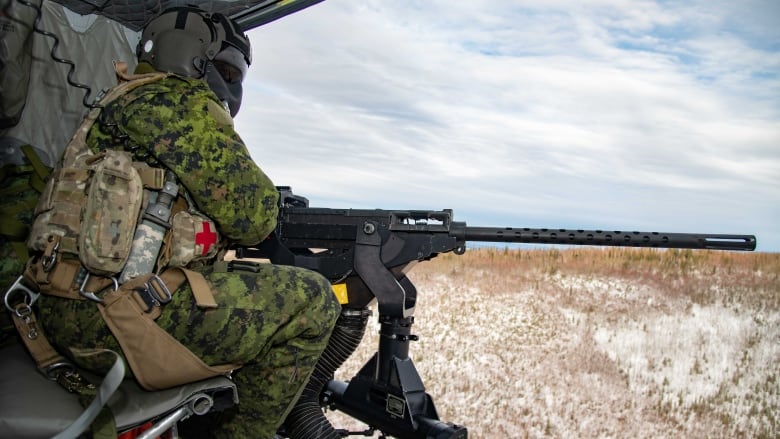Federal budget's funding boost for defence spread out over multiple years
Funding for military housing not kicking in until next year

The new federal budget promises good things will happen at the Department of National Defence next year, and hopefully in the years after.
The new fiscal plan, presented Tuesday by Finance Minister Chrystia Freeland, marks a subtlebut significant shift from what was proposed in last week's long-awaited defence policy, which committed to spending an additional $8.1 billion on defence.
The funding envelope in the budget earmarks the same amountbut includes not only the defence department but proposed spending on both the Communications Security Establishment the country's electronic spy agency and Global Affairs Canada.
While the overall defence budget is expected to increase marginally in the current fiscal year to $33.8 billion, defence experts told CBC News that when the internal cost-cutting exercise ordered by the Liberal government and the new defence policy are factored in, the military can expect roughly $635 million less this year than was anticipated before spending restraintkicked in.
Freeland's fiscal plan projects a 30 per cent increase in defence spending in the next fiscal year, bringing it to $44.2 billion.
Next year is when the federal government is expected to begin paying for some big-ticket equipment purchases such as theF-35fighters, which start arriving in 2026.
Experts ask: Where's the plan?
Sahir Khan, the executive vice-president of the University of Ottawa's Institute of Fiscal Studies and Democracy, said he would love to see the specifics.
"That's one of the difficulties, I think, with this government is we have seen a lot of aspiration, but not always the perspiration," said Khan, a former deputy parliamentary budget officer. "What is the plan to achieve the results?"
The politically charged promise to increase Canada's defence spending to 1.76 per cent of the gross domestic product by the end of the decade could be left in doubt when the spending plans are laid alongside the budget's economic projections during that time frame.
Generally, the better the economy does, the more the defence budget would have to be increased to meet the target.
"It's really unclear how we actually get to 1.76 per centof GDP, if you take the figures that are presented which outlinehow spending is going to increase," said Dave Perry, a defence expert and president of the Canadian Global Affairs Institute.
"You can't put that against the nominal GDP projection provided in the budget" and then add in other government departments, such as Veterans Affairs Canada, "and get anywhere close" to the GDP projection in the defence policy, he said.
NATO expects member countries to set aside at least two per cent of their GDP for spendingon the military. Allies have been pressuring Canada to come up witha plan to get to that target.
The federal budget does not lay out such a plan and does not address the two per cent benchmark.
"I think every ally that attends the NATO summitanniversary, the75th,in Washington this summer ... is going to be looking squarely at Canada and [asking] whether or not we actually intend to live up to the spending investment target that we just agreed to nine months ago," said Perry, whose organization hosts conferences that are occasionally sponsored by defence contractors.
Funding for several key pledges has been pushed down the road and won't show up until the next budget year in 2025-26.
Money for military housing
The Liberals are promising to build 1,400 new military homes and renovate2,500 other unitsto address an affordability crisis that has reduced some members of the military to living in vehicles.
But incremental funding for military housing doesn't kick in until next year's budget and only $6.9 million is being set aside then, with $1.4 billion expected to be spent "in future years."
The federal budget proposes turning some defence department property over to housing development.
"National Defence owns 622 properties across every province and territory, totalling 2.2 million hectares," the budget document says. "In addition to providing housing to many members of the Canadian Armed Forces, many of these National Defence properties in cities and communities across Canada are not fully utilized and could be unlocked to build more homes for Canadian Armed Forces members, and civilians, to live in."

Defence department properties in Halifax, Toronto and Victoria could be up for redevelopment. There are firm plans to divest 14 surplus defence properties "that have potential for housing and are not needed for National Defence operations," says the budget document.
The defence policy pledges to hire more civilian staff in the department to help shepherd major projects through the system. While $149 million has been set aside over four years for that effort, the funding does not kick in until next year.
Funding for new military equipment including new early warning aircraft to keep watch over the country's Far North for missile attacks, and long-range missiles for the army won'tsee funding until next year as well.
The budget does earmarksignificant funds, starting this year, for maintaining old fleets, including the navy's three-decade-old frigates.
Over the next five years, $1.9 billion will be spent to keep the frigate fleet afloat and to extend the lease on the navy's privately contracted supply ship. Overall, the military is expected to need up to $8.2 billion for those ship life extensions because of the slow pace in delivering replacement warships and sustainment vessels.













_(720p).jpg)


 OFFICIAL HD MUSIC VIDEO.jpg)
.jpg)



























































































